Contemporary Church History Quarterly
Volume 21, Number 3 (September 2015)
Review of Patrick J. Houlihan, Catholicism and the Great War: Religion and Everyday Life in Germany and Austria-Hungary, 1914-1922 (Cambridge: Cambridge University Press, 2015). Xiii + 287 Pp. ISBN: 978-1-107-03514-0.
By Kyle Jantzen, Ambrose University
Catholicism and the Great War is a transnational comparative history of everyday Catholicism. In it Patrick J. Houlihan sets out to revise the story of Roman Catholic theology and lived religion during the First World War era in both Germany (where Catholics were a minority) and Austria-Hungary (where they comprised a majority). His subjects include church leaders, military chaplains, front soldiers, women and children at home, and the papacy. And his scope is not only the war but also its immediate aftermath, which allows him to tackle the additional themes of memory and commemoration. This is an ambitious book.
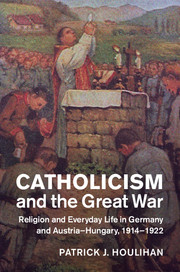 Houlihan’s argument is that conventional interpretations of religion in the First World War, which emphasize the secularizing effect of a shattering war experience as expressed in the voices of cultural modernists, do not capture the experiences of German and Austro-Hungarian Catholics. Rather, he asserts that Catholics adjusted to industrial warfare because their transnational faith and its practices helped them to cope relatively successfully with the upheaval and brutality of war—more successfully than Protestants, whose faith (in the case of Germany) was more closely tied to the defeated state.
Houlihan’s argument is that conventional interpretations of religion in the First World War, which emphasize the secularizing effect of a shattering war experience as expressed in the voices of cultural modernists, do not capture the experiences of German and Austro-Hungarian Catholics. Rather, he asserts that Catholics adjusted to industrial warfare because their transnational faith and its practices helped them to cope relatively successfully with the upheaval and brutality of war—more successfully than Protestants, whose faith (in the case of Germany) was more closely tied to the defeated state.
The book begins with a dense introduction, demonstrating Houlihan’s remarkable historiographical knowledge. Here and throughout the book, the author interacts substantively with a wide array of scholarly literature on religion and war, the First World War, nineteenth- and twentieth-century European Catholicism, military chaplaincy, religion and nationalism, women’s experiences of war, and numerous other topics. It is indeed the strength of his work.
Methodologically, Houlihan eschews quantitative or institutional history, embracing a transnational approach to his subject, which fits well with the internationalism of Roman Catholicism and enables him to avoid the trap of viewing Christian religion only in terms of its instrumental service to national movements and state interests. He also pursues a comparative methodology, highlighting differences between the experiences of German and Austro-Hungarian Catholics, though often distinctions are blurred as examples are drawn freely from both regions. Still, it is worth noting that Houlihan finds Austro-Hungarian Catholicism to have been a vital component in maintaining imperial loyalty and social cohesion, problematizing commonly-held assumptions about the inevitable demise of the Habsburg Empire. Finally, Houlihan also attempts to incorporate elements of the history of everyday life of Central European Catholics, and to blur boundaries between battlefront and homefront, creating what he calls a “family” history of Catholicism in the First World War (16).
All of these streams of interpretation are worked out in a series of chapters on Catholicism before the war, Catholic theology during the First World War, the role of Catholic military chaplains, the experiences of Catholic soldiers, the circumstances of Catholic women and children at home, the influence of the papacy, and memory and mourning among Catholics after 1918.
Leading up to the war, Catholics in Austria-Hungary were overwhelmingly rural, living in traditional local communities of belief. At the same time, however, new imagined communities were emerging in Central Europe, thanks to the various national movements which were often connected to Catholicism. German Catholics, on the other hand, were influenced most powerfully by the legacy of the Kulturkampf, which drove Catholics into a defensive posture, as demonstrated by Catholic political and labour movements. But for most Catholics in Central Europe, the outbreak of war in 1914 was seen mainly as yet another trial to be endured, and as a threat to the coming harvest.
Once the war had begun, German and Austrian bishops were prominent public advocates of just-war theology. For German Catholic leaders, war was a patriotic test of faith. For Austro-Hungarian bishops, it was a call to defend Habsburg dynastic honour and therefore the divine order as they understood it. Military chaplains played a significant role in mediating this theology to ordinary participants, not least by praying for divine blessings on military weapons. As the war dragged on, though, public theology began to emphasize the war as a punishment for aspects of modernity that had drawn Europeans away from God and the Church. And after defeat in 1918, Catholics in former Habsburg lands found themselves reimagining themselves at the dawn of a new day of freedom and opportunity—at least those from minority groups formed into new nation states, such as Czechs, Slovaks, Croats, Poles, and Slovenes. While the “new theologies” of Max Scheler, Romano Guardini, and Karl Adam would bear fruit only later in the 1960s, other “everyday theologies” were also emerging: positively, the rise of a feminine form of Catholicism; negatively, an upsurge of Catholic antisemitism which would later help to pave the way for Hitler and the Holocaust.
Military chaplains—of which there were 1441 in the Prussian Army and 3077 among the Habsburg forces—provided pastoral care among Catholic troops. This they did more effectively in Austria-Hungary than in Germany, according to Houlihan, who uses a case study of Tyrolean Catholics to support this point. Still, all chaplains were overwhelmed by the magnitude of industrial warfare. Houlihan notes that Catholic chaplains enjoyed better reputations than their Protestant counterparts, since they tended to serve closer to the front lines. In one of the best sections in the book, Houlihan explains how chaplains used the three sacraments of communion, confession, and extreme unction to minister to their troops. On the Western Front especially, the cramped quarters of static trench lines made holding a full Mass a rare event. In the end, Houlihan argues that 1916 was a watershed year. Triumphalist “God-with-us” pronouncements gave way increasingly to private doubts about God’s support in war and public reassurances of Christian hope and perseverance in times of suffering.
Among front line soldiers, Houlihan argues that Catholic religion served them better than has often been assumed, in light of the prominent modernist literature of authors like Jaroslav Hašek, Robert Graves or Erich Maria Remarque. Rather, Catholicism was surprisingly resilient in modern conflict, as ordinary soldiers coped with their circumstances by means of a mix of transnational Church institutions, sacramental practices, correspondence with home, superstition (including amulets, talismans, and letters of protection), and popular piety focused on saintly and Marian intercession.
On “the unquiet homefront,” Catholic women and children both suffered and benefitted from the war. Wartime disrupted traditional gender roles. Though public roles for women included war relief, nursing, and industry increased markedly, Houlihan argues that Catholic women in rural Central Europe tended to embrace more conservative, traditional roles. Just as the Virgin Mary was a powerful symbol for frontline soldiers, so too was Mary was a powerful symbol for Catholic women, either in her virginity or her motherhood. Above all, the home front was a nostalgic ideal of piety and peace. Family networks provided comfort—both for soldiers at the front and their wives and family members left at home. And although the First World War opened up new public opportunities for women, Houlihan finds that most rural Catholic women remained focused on local and domestic concerns and traditional religious practices.
Stepping back from the history of everyday religion, Houlihan argues that the Holy See remained fairly impartial during the early years of the war, “nearly bankrupting itself through its devotion to its caritas network of care, especially for POWs, displaced persons, and children” (188). Pope Benedict XV forecast a bloody, brutal war, but argued that the bonds of common humanity and the institutions of the Roman Catholic Church could serve as a force for peace and unity. To that end, his Papal Peace Note of August 1917 called upon the belligerents to embrace peace and civilization. Benedict also oversaw a major revision of Canon Law (1917) designed to strengthen papal power and reinvigorate the Church. Lastly—and here Houlihan returns to his ordinary Catholics—Benedict was important as a symbol. Indeed, many ordinary Catholics wrote to him, hoping he could personally intervene on their behalf or bring peace and reconciliation to a war-torn world.
In his final chapter, Houlihan carries his examination of German and Austro-Hungarian Catholicism into the postwar era, arguing that traditional religious imagery helped Europeans make sense of the war. Themes of collective sacrifice, deference to authority, and universal suffering, grief, and consolation were manifest in monuments and commemorative services, as they had been in the Mass in Time of War. Clergy played an important pastoral role in comforting families of fallen soldiers, just as relics, votive tablets, and other physical objects of memorialization honoured the war dead.
As wide-ranging and as steeped in the secondary literature as Houlihan’s book is, it suffers from a significant lack of primary source evidence. The author acknowledges this in his preface, noting how hard it is to find archival traces of “prayers, fears, and suffering.” As a result, he asserts that his book “is a religious history that gives an impressionistic portrait” (15). It is of course true that this kind of source material is hard to come by, which is why studies of the interior lives of ordinary people are so often local or micro-historical in nature. Repeatedly, Houlihan makes large generalizations based on scant evidence, as in the case of his assertion that Catholics were worried about the impact of the outbreak of war on the coming harvest. This stands to reason, but the statement, “To many Catholics, war was another cyclical plague, redolent of the sinful human condition; it was not cause for celebration” is supported only by one memoir from a Lower Austrian domestic servant and three secondary sources (48). To give another example, a single diary from an Austrian soldier provides the supporting evidence for the conclusion that “soldiers who had to experience the daily horrors of battle often used their faith to cope” (70). Similarly, a single photo of a church service in Weimar Germany along with two references to secondary sources serves to counter the prevailing historiographical view of declining public piety after the First World War (260-261). And no explanation is provided for why a case study of Tyrol would serve to explain the relationship between military chaplains and soldiers throughout Germany and Austria-Hungary (81-82). In sum, while there is little reason to doubt that traditional Catholic religious practices persisted in rural Central Europe during and after the war, Houlihan’s wide-ranging study of this topic makes overly large claims which rest on overly thin evidentiary foundations. Simply put, it is impossible to discern whether or not the phenomena he describes are generally true for early twentieth century Catholicism in Germany and Austria-Hungary, since the his source material is drawn unsystematically from a wide array of regions and positions within Catholicism. He would be far more successful building his case through a series of studies like his useful regional analysis of German military chaplains in occupied France (Houlihan, Patrick J. “Local Catholicism as Transnational War Experience: Everyday Religious Practice in Occupied Northern France, 1914–1918.” Central European History 45, no. 2 (June 2012): 233–67), where his mastery of the secondary literature is combined with a solid and representative collection of evidence.

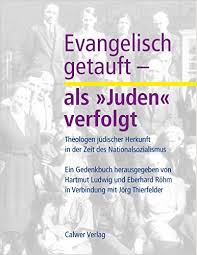 Evangelisch getauft—als “Juden” verfolgt is not a comprehensive history of this topic; nonetheless it is a valuable contribution to the literature. As its subtitle indicates, it is primarily a Gedenkbuch with brief biographies of 180 German Protestants whose lives were changed by the racial laws and the responses of their church. The editors have cast a wide net. The individuals profiled here include not only theologians and members of the Christian clergy, but individuals who were barred from studying theology before 1945 and others who, barred from other professions, decided to study theology in exile. Also included are teachers of religious education, Christians in “mixed” marriages, Austrians who came under Nazi law after 1938, and even several individuals who were Deutsche Christen or members of the Nazi party. While most of those profiled were members of the German Evangelical Church, there are also several profiles of individuals from Methodist, Baptist, and other free churches.
Evangelisch getauft—als “Juden” verfolgt is not a comprehensive history of this topic; nonetheless it is a valuable contribution to the literature. As its subtitle indicates, it is primarily a Gedenkbuch with brief biographies of 180 German Protestants whose lives were changed by the racial laws and the responses of their church. The editors have cast a wide net. The individuals profiled here include not only theologians and members of the Christian clergy, but individuals who were barred from studying theology before 1945 and others who, barred from other professions, decided to study theology in exile. Also included are teachers of religious education, Christians in “mixed” marriages, Austrians who came under Nazi law after 1938, and even several individuals who were Deutsche Christen or members of the Nazi party. While most of those profiled were members of the German Evangelical Church, there are also several profiles of individuals from Methodist, Baptist, and other free churches.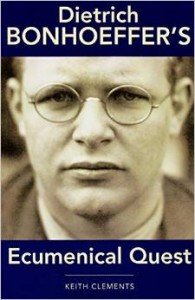 In fact, Bonhoeffer’s participation in ecumenical affairs started immediately after his return in September 1931 from his visit to the United States. He was sent as a German youth delegate to a meeting in Cambridge of the World Alliance for Promoting International Friendship through the Churches. This body had originally been established in 1914, but had to suspend its activities during the war, and had only been resuscitated in 1920. Its support came from influential lay and clerical leaders, particularly in the democratic countries of Western Europe and North America. They recognized the need for programs of reconciliation and peace activities in order to bind up the wounds caused by the destructive violence of the recent war. It was here that Bonhoeffer met with such leading figures as the Anglican Bishop George Bell of Chichester, with whom he was to collaborate for the next decade.In fact, Bonhoeffer made such an impact that he was forthwith appointed as an Honorary Youth Secretary and given responsibility for the World Alliance’s youth work in central Europe. This was a challenge he could hardly refuse, and one to which he brought his newly-minted skills in theological advocacy and his energetic support of the World Alliance’s aims.
In fact, Bonhoeffer’s participation in ecumenical affairs started immediately after his return in September 1931 from his visit to the United States. He was sent as a German youth delegate to a meeting in Cambridge of the World Alliance for Promoting International Friendship through the Churches. This body had originally been established in 1914, but had to suspend its activities during the war, and had only been resuscitated in 1920. Its support came from influential lay and clerical leaders, particularly in the democratic countries of Western Europe and North America. They recognized the need for programs of reconciliation and peace activities in order to bind up the wounds caused by the destructive violence of the recent war. It was here that Bonhoeffer met with such leading figures as the Anglican Bishop George Bell of Chichester, with whom he was to collaborate for the next decade.In fact, Bonhoeffer made such an impact that he was forthwith appointed as an Honorary Youth Secretary and given responsibility for the World Alliance’s youth work in central Europe. This was a challenge he could hardly refuse, and one to which he brought his newly-minted skills in theological advocacy and his energetic support of the World Alliance’s aims.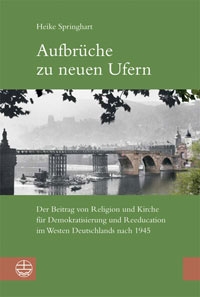 Heike Springhart’s Aufbrücke zu neuen Ufern is a detailed history and analysis of one such program, the partnership between the U.S. military government and German Protestant church leaders and organizations in Württemberg. Her focus is the work there of the U.S. Branch for Education and Religious Affairs (ERA) between 1946-1948, which she sets in a broader historical context by examining the individuals and organizations, both in the U.S. and in Germany, who during the war helped lay the theoretical and political foundation for the ERA’s work. There is also a concluding chapter that offers a conceptual framework for understanding the potential role of religion in post-conflict processes of democratization and social transformation, drawing on the German example as a case study.
Heike Springhart’s Aufbrücke zu neuen Ufern is a detailed history and analysis of one such program, the partnership between the U.S. military government and German Protestant church leaders and organizations in Württemberg. Her focus is the work there of the U.S. Branch for Education and Religious Affairs (ERA) between 1946-1948, which she sets in a broader historical context by examining the individuals and organizations, both in the U.S. and in Germany, who during the war helped lay the theoretical and political foundation for the ERA’s work. There is also a concluding chapter that offers a conceptual framework for understanding the potential role of religion in post-conflict processes of democratization and social transformation, drawing on the German example as a case study.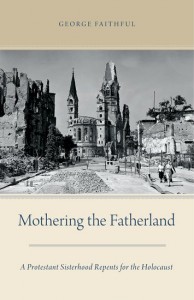 Mothering the Fatherland is a focused and sympathetic study of the life and work of a unique group of women who were so haunted by the Holocaust that, in the wake of the Second World War, they formed a Protestant sisterhood focused on intercessory repentance by the “true” Christians of Germany for the sins committed by the nation during the Third Reich. It is an absorbing work of historical theology that is especially significant for the effective manner in which the author situates the theology and practice of the sisterhood in their historical and intellectual contexts and for the author’s thoughtful analysis of the theology of the sisterhood’s co-founder.
Mothering the Fatherland is a focused and sympathetic study of the life and work of a unique group of women who were so haunted by the Holocaust that, in the wake of the Second World War, they formed a Protestant sisterhood focused on intercessory repentance by the “true” Christians of Germany for the sins committed by the nation during the Third Reich. It is an absorbing work of historical theology that is especially significant for the effective manner in which the author situates the theology and practice of the sisterhood in their historical and intellectual contexts and for the author’s thoughtful analysis of the theology of the sisterhood’s co-founder.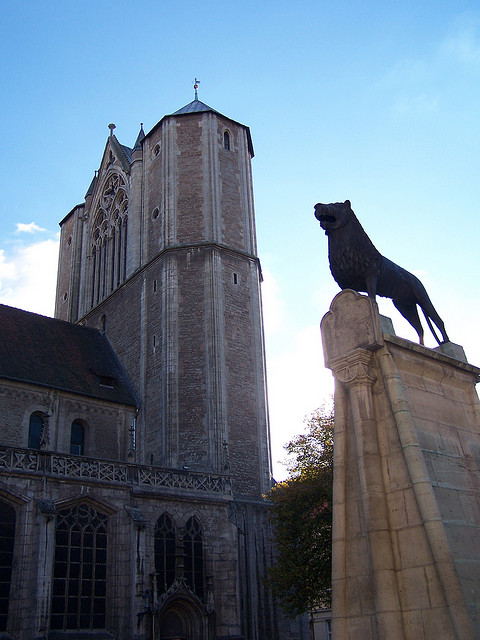
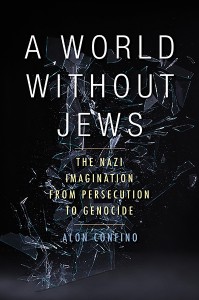
 The cover announces the character of the theme: it is the image of a stained glass window in Worcester Cathedral showing three resolute figures looking up towards the sky, intent, devout, broadly sanguine. One is a nurse and the other two are men of the Royal Navy and the Royal Air Force. The task that David Nash has set himself here is a striking one: in what kinds of narratives might the historian find the relationship between religious faith and active public life in the British twentieth century? How are we to locate the dimension of personal faith in the discussions and dramas of society at large? How are we to know when it is there – or when it is not?
The cover announces the character of the theme: it is the image of a stained glass window in Worcester Cathedral showing three resolute figures looking up towards the sky, intent, devout, broadly sanguine. One is a nurse and the other two are men of the Royal Navy and the Royal Air Force. The task that David Nash has set himself here is a striking one: in what kinds of narratives might the historian find the relationship between religious faith and active public life in the British twentieth century? How are we to locate the dimension of personal faith in the discussions and dramas of society at large? How are we to know when it is there – or when it is not?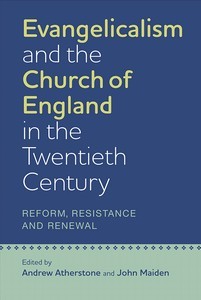 The opening chapter, written by two Oxford scholars, examines the taxonomy of recent English Evangelicalism, describing the various strands within this spectrum of belief, which share common features in their adherence to the key truths of justification by faith alone and the supreme authority of Holy Scripture as the word of God. Nevertheless each of these strands places its emphasis on different aspects of the faith. Conservative Evangelicals stress the inerrancy of the Bible and refuse to accept the scientific evidence for evolution. More “open” Evangelicals have accepted both the modern theories about the world’s origins and many of the findings of biblical criticism, while most recently the contribution of the charismatic movement, drawn from Pentecostalism, and found in such London churches as Holy Trinity, Brompton or St Paul’s, Onslow Square, has reinvigorated and popularized Evangelicalism among young people. The rivalries—and sometimes the acerbic criticisms of these groups of each other—have meant that English evangelicalism often seems to have been in a constant process of reconfiguration.
The opening chapter, written by two Oxford scholars, examines the taxonomy of recent English Evangelicalism, describing the various strands within this spectrum of belief, which share common features in their adherence to the key truths of justification by faith alone and the supreme authority of Holy Scripture as the word of God. Nevertheless each of these strands places its emphasis on different aspects of the faith. Conservative Evangelicals stress the inerrancy of the Bible and refuse to accept the scientific evidence for evolution. More “open” Evangelicals have accepted both the modern theories about the world’s origins and many of the findings of biblical criticism, while most recently the contribution of the charismatic movement, drawn from Pentecostalism, and found in such London churches as Holy Trinity, Brompton or St Paul’s, Onslow Square, has reinvigorated and popularized Evangelicalism among young people. The rivalries—and sometimes the acerbic criticisms of these groups of each other—have meant that English evangelicalism often seems to have been in a constant process of reconfiguration.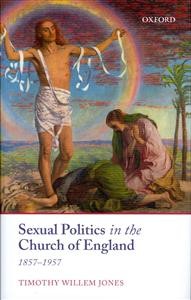 Timothy Jones follows this lead by undertaking a study of the major changes in gender politics in the Church of England from the mid-nineteenth to the mid-twentieth century. He focusses on six episodes during this period which, he claims, demonstrated the often reluctant posture of the church leaders when challenged to take a stand on matters affecting gender or sexual politics. Over the course of this hundred year span, English society evolved rapidly and adopted a much more liberal stance, which was often reflected in parliamentary debates, and found its way into progressive legislation. The result was a frequent clash of interest with the more conservative and traditional sectors of opinion, including those of the Church of England. Jones begins his survey with the debates about marriage in the mid-1850s and concludes with the heated controversies about consensual homosexuality in the 1950s. Rather than indulging in detailing the reactionary attitudes of some Church of England leaders, Jones skillfully weaves into his account the variety of positions taken over the years, and displays a commendable sympathy for most of the participants in this on-going search for new understandings amongst church members about gender and sexual politics.
Timothy Jones follows this lead by undertaking a study of the major changes in gender politics in the Church of England from the mid-nineteenth to the mid-twentieth century. He focusses on six episodes during this period which, he claims, demonstrated the often reluctant posture of the church leaders when challenged to take a stand on matters affecting gender or sexual politics. Over the course of this hundred year span, English society evolved rapidly and adopted a much more liberal stance, which was often reflected in parliamentary debates, and found its way into progressive legislation. The result was a frequent clash of interest with the more conservative and traditional sectors of opinion, including those of the Church of England. Jones begins his survey with the debates about marriage in the mid-1850s and concludes with the heated controversies about consensual homosexuality in the 1950s. Rather than indulging in detailing the reactionary attitudes of some Church of England leaders, Jones skillfully weaves into his account the variety of positions taken over the years, and displays a commendable sympathy for most of the participants in this on-going search for new understandings amongst church members about gender and sexual politics. The Holy Land is of course full of holy history, also of holy geography. Stuhlmann sees his job as motivating his young guests from Europe to understand the dimensions of both these features and to encourage a courageous encounter with the many history-laced dilemmas which are met in so many corners of the “promised” land. He is clearly against the kind of religious tourism which brings Christian visitors to Israel, but seeks to isolate them in the first century without ever meeting with Israel’s present-day inhabitants or their troubles. He is equally opposed to the kind of narrow eschatological proclamation of certain Christian groups, especially some American evangelicals, or to the equally one-sided Jewish extremists who wage a continual battle against their Palestinian neighbours. He is grateful for the fact that he and his younger colleagues from Germany are now looked on as representatives of the “new Germany”, and that the horrors of the Holocaust, though loudly trumpeted in state-controlled media, are not attributed to the younger generation or to him personally. Likewise he is encouraged by the friendliness of the Palestinians who see these visitors from Europe as a hopeful sign that their cause is not being forgotten by the rest of the world. And he draws hope from the fact that there are many signs of confidence building between young Jews and Arabs, not least those established at Nes Ammim itself.
The Holy Land is of course full of holy history, also of holy geography. Stuhlmann sees his job as motivating his young guests from Europe to understand the dimensions of both these features and to encourage a courageous encounter with the many history-laced dilemmas which are met in so many corners of the “promised” land. He is clearly against the kind of religious tourism which brings Christian visitors to Israel, but seeks to isolate them in the first century without ever meeting with Israel’s present-day inhabitants or their troubles. He is equally opposed to the kind of narrow eschatological proclamation of certain Christian groups, especially some American evangelicals, or to the equally one-sided Jewish extremists who wage a continual battle against their Palestinian neighbours. He is grateful for the fact that he and his younger colleagues from Germany are now looked on as representatives of the “new Germany”, and that the horrors of the Holocaust, though loudly trumpeted in state-controlled media, are not attributed to the younger generation or to him personally. Likewise he is encouraged by the friendliness of the Palestinians who see these visitors from Europe as a hopeful sign that their cause is not being forgotten by the rest of the world. And he draws hope from the fact that there are many signs of confidence building between young Jews and Arabs, not least those established at Nes Ammim itself.